One of these dangers is playing in or around water. Water can refresh on a hot day, but it’s important to take some safety precautions before letting your dog take a dip.
There are a few things you can do to help keep your dog safe near water. One of the most important is to make sure they always have a way out of the water.
This means having proper fencing around pools and other bodies of water, having a good quality dog pool ladder, and making sure your dog knows how to swim.
You can also buy lifejackets or vests for dogs, which will help keep them afloat if they fall into deep water.
Finally, be aware of your surroundings and never leave your dog unsupervised near water. A moment’s distraction can lead to a tragedy.
By following these simple tips, you can help prevent drowning or injury to your dog.
Can My Dog Swim?
People assume any dog can do it. But some dogs have a pretty difficult time staying afloat, especially if they have done little swimming before.
Not all dogs swim naturally, and the less body fat they have, the harder it is for them to float. If your dog is new to swimming—or if he’s young, old, weak, or just plain skinny—it might be hard for him to keep his head above the water.
Some dog breeds can swim really well, like spaniels and retrievers, but others (like bulldogs) are not as good in the water. A dog life jacket is a smart investment if your pup and you plan to spend time on or near the water. Even the most skilled swimmers can get tired and have difficulty staying upright in the water.
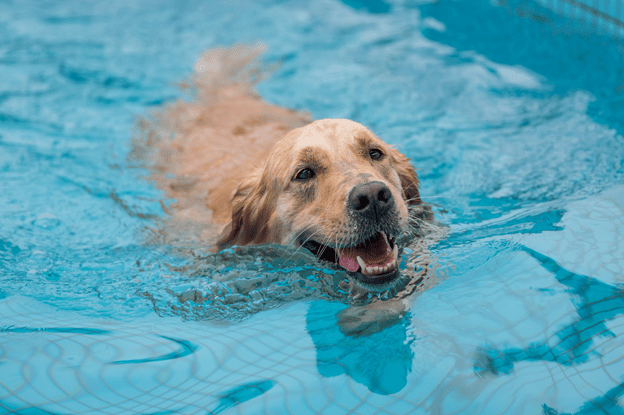
Teach your dog how to get in and exit the pool
Swimming pools can be dangerous for dogs because pools don’t slope to the ground like streams or lakes. There are steps and ladders to get out of the pool that can help with this. Although your dog may not be able to climb a ladder, most dogs can use steps if they know how to find them.
Teaching a dog how to walk up and around the steps of a swimming pool is the first step. Dog treats can get most dogs to walk up and down the steps.
Your dog might not follow a food lure to the pool because he doesn’t like the water. You wouldn’t want to be forced into the pool if you didn’t enjoy the water. Don’t force your dog to go into the pool if he doesn’t like it.
A pool’s steps are meant for humans. Don’t assume your dog will follow the steps to get out of the pool. Your pet should be taught where the stairs are located and how to use them. Keep in mind that pool steps are below the surface of the water and are typically the same color as the pool interior. That lack of visibility and lack of contrast make it very difficult for a dog to see them.
A Gradual Entry
A gradual entry is the best way to get your dog used to swim. The first step is to introduce your pet to water. It is important to make a man’s best friend feel comfortable standing in water.
Start at the shallow end of the pool, on the steps. He will stand straight up with his head above the water. You can place a leash around him and encourage him to walk slowly up the steps.
A better spot may exist than the entry steps, depending on the design of your pool. Your pet may find it difficult to enjoy the water if the steps leading to the pool are too large, especially if they are small.
Repeat the process until your dog is comfortable on the step. Your pet should be led off the step and allowed to exit the pool. Then, return to the step immediately, exit the water to the deck and then continue the process.
The first few times you spend in the pool should be short
Dogs, like humans, need to increase their strength before they can engage in new activities. Although most dogs can swim, the dog paddle differs from a trot on land. Dogs can get tired quickly learning to swim because they use different muscles in the dog paddle.
Begin a session with your dog for five minutes. If your dog gets tired, stay in the pool together so that you can direct him to the stairs. An anxious dog may swim off to the wrong side or go around in circles trying to find his way out. For the first few weeks of your dog’s time in the pool, place a flag or cone near the steps to help him find them. From there, you can increase your pool time.
Be careful when you combine playtime and swim time. Dogs that jump in the water to retrieve toys naturally sink deeper than dogs who walk in them. Before you allow your dog to swim, make sure they are comfortable.
Do not throw your dog in the pool. Even if your dog doesn’t touch the bottom or side of the pool, it is possible for him to panic and sink.
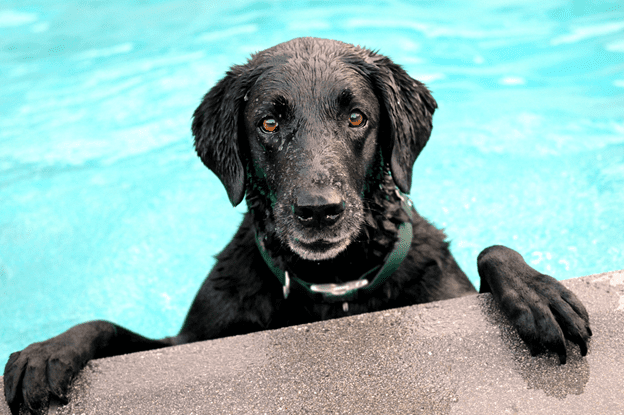
Fun in the Pool
First, never leave your dog unattended near the pool. Even if she knows how to use the ladder, she may still get into trouble if she’s left alone.
Teach your dog how to swim. Some dogs are natural swimmers, but others need a little help to get comfortable in the water.
Never force your dog into the water if they are resistant. Some dogs dislike being in the water and there is nothing wrong with that. Respecting their wishes will keep both of you happy.
Make sure you provide plenty of toys, so they have something to do while they are in the pool. This will help keep them from getting bored and wanting to jump out.
Finally, always supervise your dog while they are swimming, and be sure to call them over to the ladder when it’s time to get out.
Post-Swim Routine
After your dog is out of the pool, it’s best to get dry. This can cause fur mats and discomfort. Your pet can also get water in their ears. After swimming, you can rinse your pet with a hose to remove chlorine from their skin. To dry your dog, use an absorbent towel. To remove any chlorine or other debris, wash their ears with a veterinary ear cleaner.
Do not bathe your dog more than once a week or as directed by your veterinarian. Too much shampoo can cause skin irritations.
Dog Pool Ladders
If you have a pool in your backyard, it’s important to take steps to keep your dog safe. One way to do this is by installing a dog pool ladder.
A dog pool ladder gives your dog a way to get in and out of the pool designed for them. It’s important to choose a ladder that is designed for dogs, as some human-sized ladders can be too steep or slippery for them.
There are several types of dog pool ladders available, so be sure to choose one that’s best suited for your needs. Some dog pool ladders are designed for smaller dogs, while others are made for larger breeds.
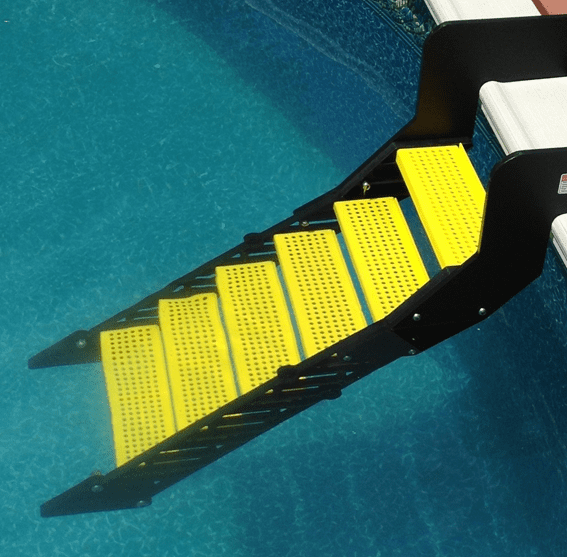
Where You Will Use It
Before you shop for a pool ramp or steps, first consider what type of pool it is. Most steps attached to a deck surrounding the pool. On in-ground pools this may be concrete or masonry; on above-ground pools it may be a wood or plastic lumber deck. Most dog stairs need to be secured on a stable, flat surface. Avoid pool ramps or steps that require contact with the inside surface of the pool to avoid damaging it.
Size of Weight Limits
A pool ramp for dogs must be able to support the dog’s weight and not move when the weight is applied which will scare the dog. It should also allow for natural steps. The ramp’s width and height (vertical rise) should be considered ensuring there are enough steps in the water so the dog can swim on and walk out. You do not want your dog doing gymnastics to get out.
Tractive Force
Dog ramps must be strong enough to prevent accidental slips and injuries. Look for steps and platforms with textured surfaces, sufficient drainage, and raised edges (toe plates) on the back side of the step to prevent sliding through to ensure a safe exit from the pool.
Durability
Dog ramps can be damaged by water and the sun. Your dog cannot use them safely if they are damaged. You should always choose a UV- and chemical-resistant dog ladder to your backyard pool so they don’t get mildew, crack or rot.
Make sure the ladder you choose is sturdy and durable. Be sure to read the manufacturer’s instructions so you know how to install it.
By installing a dog pool ladder and following some simple safety guidelines, you can relax and enjoy watching your dog have a great time.
Swimming with dogs can be a lot of fun – make sure they stay safe while playing in the water! Investing in a dog pool ladder is a great way to ensure their safety.

What about above-ground pools?
You will most likely have an above-ground pools will not have built-in steps like some in-ground pools so a dog pool ladder is essential. There is likely a human ladder at one location. Some dogs may be able to go up these, but the risk of injury is significant. You are offering your dog options by installing a dog pool ramp. You can give your pet an exit point with a dog pool ramp.
Many pet owners find it more important to have a dog pool ladder when you have an above-ground swimming pool. It may be easier for your furry friend to access your deck at the edge of the pool and fall in. You may still need to install a dog pool ladder to allow your dog to access the poolside.
No matter what type of pool you have, dog pool ramps are a great idea. This will make your dog even more part of the summer fun. It takes a little training and the right pool ramp, but you can relax knowing that if your pet falls into the pool, they’ll be able to get out easily.
Pool Tips
Rinse Before Plunging In
Before entering a swimming pool, many people wash their bodies. This is a good idea for dogs too. You don’t want to make the pool a bathtub for your dog. Your filter will be more stressed if your dog is not pre-rinsed. It is not a good idea to let your dog run through grass and dirt before you take them to the water. To get your dog to the pool, it might be necessary for you to take him or her to a lift.
Don’t Drink the Water
Dogs are naturally inclined to pant when exposed to heat. Don’t allow your pet to drink the pool water. Pool chemicals are not good for your dog. Make sure your pet has access to fresh water whenever they need it.
Many dog owners worry about the safety of their dogs in chlorine pools. To keep pool water clean and free from microorganisms, chlorine is often added. These chemicals can cause irritation to the skin, eyes, nose, and ears of dogs. Some dogs are more sensitive to chlorine than others, just like humans. It is important to rinse your dog with fresh water after they have finished playing in the swimming pool.
Ear infections can occur after prolonged exposure to the pool water. After your dog has finished swimming, make sure you provide proper dog ear care. To get rid of any moisture or trapped water, give their ears a gentle rub using a towel.
If swallowed, chlorine can cause stomach irritation. This is more common in dogs who are excited to swim, retrieve toys, or are fatigued. Bloat is caused by excessive water intake, so owners should be vigilant. If your dog appears distended or is trying to vomit, consult your vet immediately.
A Resting Spot
Dogs love water just as much as humans, but they will eventually tire of the water. Your dog’s legs cannot reach the bottom of the swimming pool, so they will need a place to rest. Dog pool ladders provide a wonderful way for your dog to take a break from swimming. A spot on the deck can be a great resting spot. If the dog is small enough, you might consider a float as a fun option.
Pool Filter Maintenance
Filter maintenance intervals are shorter for pools with dogs. Shedding hair will quickly clog your skimmer or pre-filter and the dirt and debris from their coats and paws will quickly add to the filter’s challenge of keeping the water clear and clean.
Dog Life Jackets
One of the best ways to keep your dog safe around water is to invest in a quality life jacket. But with so many types and brands on the market, how do you choose the right one for your pup?
Some dogs can swim well naturally, and water doesn’t bother them in the least. Others struggle to stay afloat and may tire quickly. Brachycephalic dogs, with are short-snouted dogs, are particularly at risk of being overcome by water.
Here are a few things to consider when selecting a life jacket for your dog:
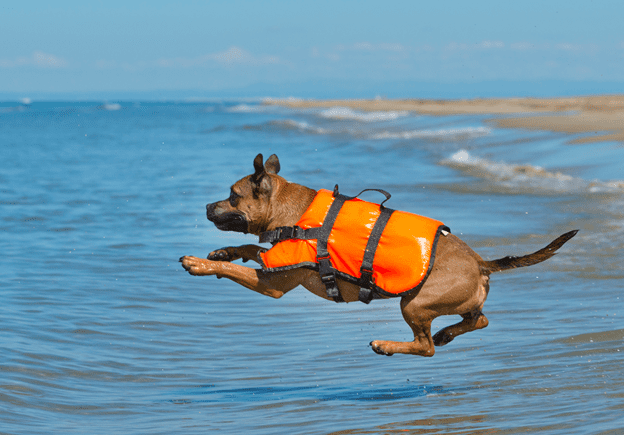
Handle
A handle for the dog life jacket makes it easier to grab your dog if needed. It makes it easy to teach your dog to swim. You can help them swim until they are confident in the water.
D-Ring
A D-ring should be attached to the dog’s vest or jacket so that it can be used as a leash.
Choose between a vest or a jacket for your dog’s life. Dog life jackets provide visibility and buoyancy and cover more of your dog. These jackets are recommended for water sports such as boating. A life vest might work well if your dog prefers to swim in the pool. A life vest is lighter and covers less of your dog. It is also easier to use for casual swimming.
Size
It’s important to choose a life jacket that fits your dog. If it’s too large, your dog may wiggle out of it; if it’s too small, it could be uncomfortable and restrictive.
Use a measuring tape to measure your dog’s girth (the widest part of their chest) and consult size charts from different brands to find the best fit.
Weight
Not all life jackets are equal – some are designed for small or lightweight dogs, while others are for bigger, heavier dogs. Choose a jacket that’s appropriate for your dog’s weight.
Type
There are a few different life jackets available on the market. Choose one that is most appropriate for your dog’s needs. For example, if you’re taking your dog boating, you’ll need a jacket with a built-in flotation device; if they’re going to be playing in the water at the beach, a simpler design may be more suitable.
Color & Trim
Make sure the dog life jacket is colorful with reflective trim to make it easy to see. Some life jackets come with handles to help you lift your dog from the water. This can be a very helpful feature.
Price
Life jackets can range in price from $10 to $100 or more. It’s important to find one that is affordable and fits your dog’s needs.
When shopping for a life jacket for your dog, it’s important to keep the above factors in mind. By choosing the right jacket, you can help ensure your dog’s safety while swimming and playing in the water.
Lake Tips
Pools are fun, but sometimes you have the chance to take your dog to a lake, pond, or river to play in the water. Here are a few more tips for those occasions:
- Avoid letting your dog drink the water. Lake water can contain harmful bacteria that can make your dog sick. If your dog takes a sip, rinse its mouth out with fresh water as soon as possible.
- Be careful of algae blooms. Some types of algae can be toxic to dogs, so if you see any algae blooms on the surface of the water, keep your dog away.
- Monitor your dog at all times. Lakes can be busy places, and it’s easy for a dog to wander off and get lost. Make sure you have a way to keep track of your pup at all times and stay close by when they’re in the water.
- If your dog swims in a river or creek, it may be at risk of contracting leptospirosis – a bacterial infection that can cause severe illness and even death. Other risks include exposure to parasites and harmful algae blooms.
- Watch out for boats. It’s important to keep your dog away from boats and other watercraft, as they can cause serious injuries with their propellers.
- Bring along some fresh water and snacks. Lakes can be hot, and chances are your dog will get hungry after swimming around. Make sure you have some fresh water and snacks on hand to keep them hydrated and satisfied.
- If you’re worried about your dog’s safety while swimming, it’s best to consult with your veterinarian to find out which bodies of water are safe for them to swim in.
Following these tips will help you make the most of your time at the lake while keeping your dog safe. Have fun, and stay cool!
Bring Sunscreen, Insect Repellent, & A First-Aid Kit
Sunburns and skin cancer are common in dogs, so make sure you only use sunscreen made for dogs. You can also use balms to protect your dog’s nose. You can discuss these with your veterinarian.
Your veterinarian will recommend the best sunscreen for you and your dog. Sunburns are more common in dogs with short or light-colored fur. Pay attention to areas such as the armpits, ears, and nose.
Mosquitoes can also bite dogs, as well as other insects that could carry diseases. There are insect repellents that are designed for dogs. Do not expose your dog to insecticides made for human use.
In case of an emergency, first-aid kits can be very helpful. Make sure you have a first aid kit with bandages, antibacterial cream, Dramamine, or any other medication for seasickness.
Other Water Safety Tips
Here are a few extra water safety tips for your dog:
If your dog is not a strong swimmer, consider investing in a dog life jacket.
Be aware of the signs of water intoxication and heat stroke, which can be deadly for dogs.
Bring fresh water and a bowl with you to the pool or beach so your dog can stay hydrated.
After playing in the water, rinse off your dog to remove any harmful chemicals or salt that could irritate their skin.

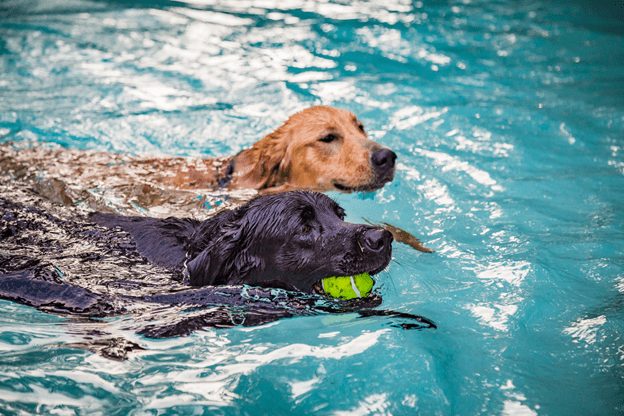
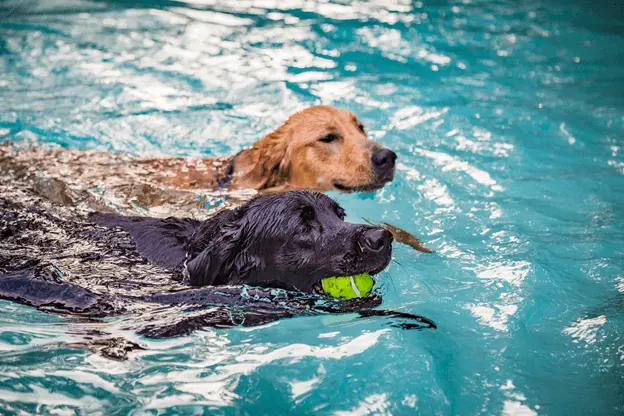
Recent Comments